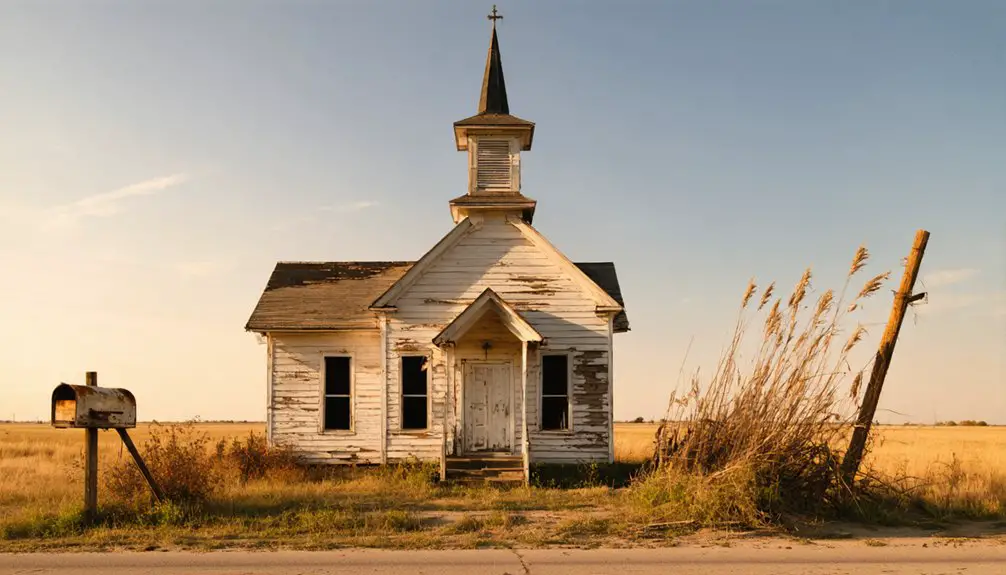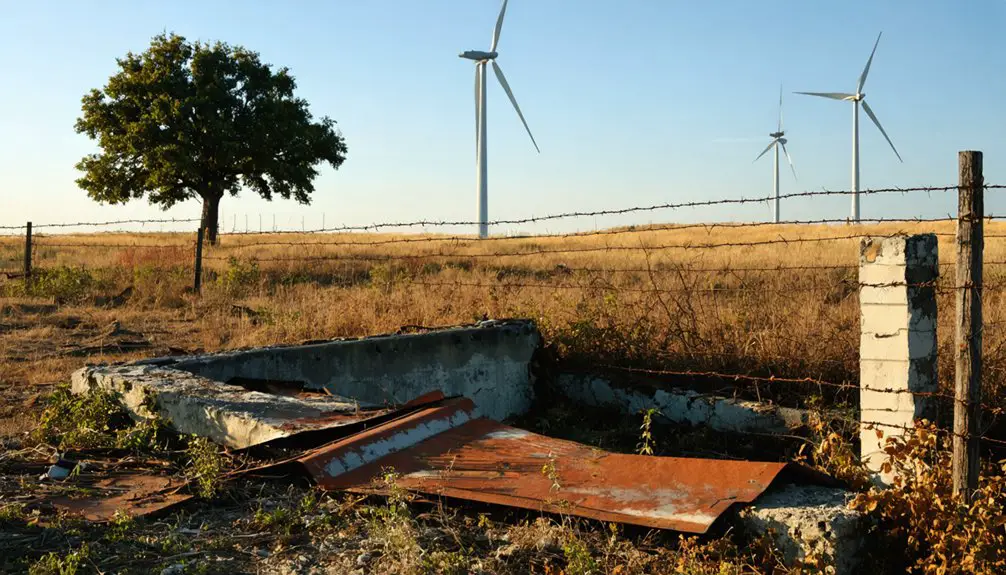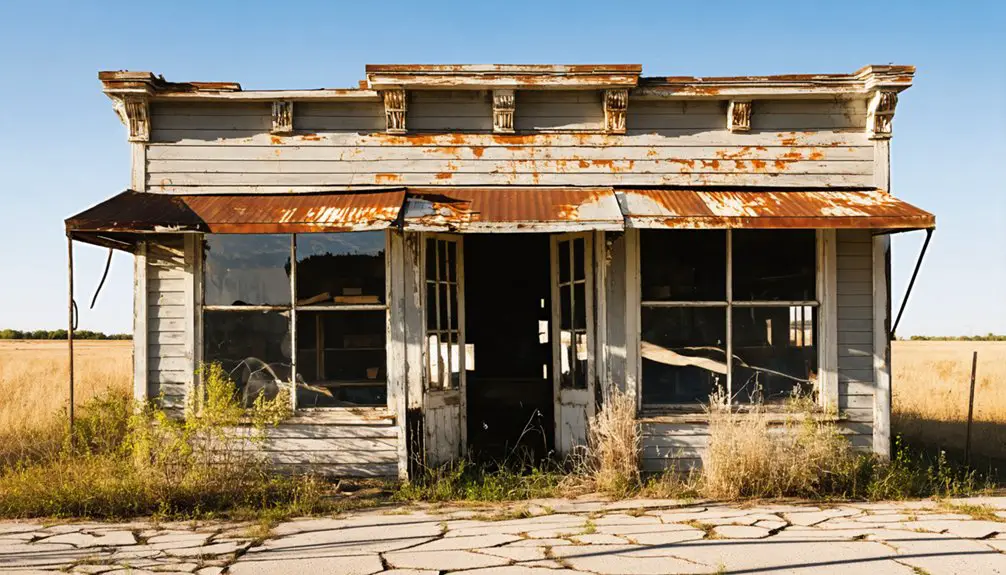You’ll find Hext, Oklahoma along historic Route 66, where it emerged in the early 1900s alongside the Choctaw, Oklahoma and Gulf Railroad. Named after farmer William Hext, the settlement operated a post office briefly from 1901-1902 before declining into ghost town status. While most structures are gone, you can still spot remnants including a stone gas station converted to a home and the ruins of a WPA school that burned in 2021. The town’s layered history reveals fascinating chapters of Oklahoma’s rural past.
Key Takeaways
- Hext emerged in early 1900s along the Choctaw, Oklahoma and Gulf Railroad but declined quickly after its post office closed in 1902.
- The town’s historic Route 66 connection began in 1929, marked by a stone gas station that was later converted into a residence.
- A WPA-built school served as a community center until its destruction by fire in 2021, leaving only partial walls standing.
- The Baptist church remains the only active institution in Hext, surrounded by privately owned farmland with no public access.
- Original 1929 Route 66 roadbed still exists beneath modern asphalt, while abandoned buildings reflect the town’s ghost town status.
The Birth of a Frontier Settlement
When homesteaders pushed into western Oklahoma Territory at the turn of the 20th century, the small settlement of Hext emerged alongside the expanding Choctaw, Oklahoma and Gulf Railroad line.
William Hext, a local farmer, lent his name to this frontier outpost where determined settlers carved out a life from the challenging prairie landscape.
From dusty prairie soil to frontier dreams, William Hext’s namesake settlement beckoned pioneers to forge their destiny in Oklahoma Territory.
You’ll find Hext’s earliest days marked by typical frontier life challenges – establishing a post office, building homesteads, and working the surrounding farmland.
Despite the promise of the railroad connection and initial settlement efforts, the community’s growth remained limited.
The post office’s brief operation from June 1901 to November 1902 reflects the settlement’s struggle to gain momentum.
While many frontier towns flourished during this period of westward expansion, Hext never managed to achieve substantial population growth or official census recognition.
A brick WPA school was constructed in the area during the 1930s, though it now stands abandoned like many other structures from that era.
The community later gained prominence as a stop along historic Route 66, though this brought only temporary attention to the area.
Life Along Historic Route 66
After Route 66 was realigned through Hext in 1929, this quiet farming settlement briefly experienced the pulse of America’s most famous highway.
Following 5th Street, the new concrete roadbed carried travelers past a lone gas station that became the town’s only remarkable stop. The name disambiguation helped distinguish this Hext from several other places sharing the same title. You’ll find that this rural nostalgia remains preserved in the scattered remnants – a stone gas station now converted into a home, and a WPA-built brick schoolhouse slowly surrendering to time.
The area features abandoned westbound lanes from the highway’s four-lane configuration that existed between 1956 and 1970.
As the last stretch of Oklahoma’s Route 66 to surrender its designation to Interstate 40 in 1975, Hext’s section of the Mother Road tells a poignant story.
While horse breeding and farming continue today, you can still trace the original 1929 roadbed beneath its asphalt covering, a proof of the highway’s enduring legacy.
A Lost Piece of Oklahoma History
Founded in 1901 as a modest farm and ranch community, Hext represents a fleeting chapter in Oklahoma’s settlement history.
You’ll find lost landmarks scattered across this forgotten landscape, where William Hext’s namesake settlement never quite fulfilled its promise. The town’s brief post office operation and the burned-out WPA school stand as silent testimonies to forgotten stories of pioneer ambition.
Between Interstate 40 and old Route 66, you’re now likely to spot only the Hext Baptist Church amid vast farmlands where a vibrant community once hoped to thrive. The school’s ruins have been captured in stark black-and-white photographs that document its steady decay.
Amid Oklahoma’s endless plains, Hext Baptist Church stands solitary, the last echo of a community’s faded dreams.
The area’s lost landmarks include an old stone gas station, while vintage artifacts like a 1940s radio once housed in the school have vanished into time.
Today, horse breeding and farming continue where early settlers once dreamed of building a lasting town.
The WPA School’s Legacy
If you’re seeking Oklahoma’s most poignant WPA structures, you’ll find the Hext school’s red brick walls and curved auditorium ceiling represented classic Depression-era architecture that served as both schoolhouse and community gathering space for three decades.
The building’s role as a rural education center, constructed during America’s greatest economic crisis, demonstrated the New Deal’s lasting impact on Oklahoma’s smallest communities. The WPA’s commitment to quality craftsmanship was evident in the school’s construction, as workers were given time to develop their above average workmanship.
After decades of abandonment and agricultural repurposing, the school’s story came to a tragic end in April 2021 when fire consumed most of the historic structure, leaving only partial walls as evidence of this important piece of Route 66 corridor history.
Historic Architecture Features
While many WPA buildings in Oklahoma shared common architectural elements, the Hext school exemplified the program’s characteristic features through its red brick construction and utilitarian design. Like the native sandstone used in many Oklahoma WPA buildings during 1936-1937, these materials demonstrated durability and regional character.
The building’s practical approach reflected the WPA architecture commonly found in rural schools, with its rectangular form and shingled roof designed for both durability and simplicity. Today’s digital preservation efforts help document and maintain records of this historic architectural style.
- Native stone and brick masonry showcased local materials and regional craftsmanship
- Symmetrical window placement maximized natural light and ventilation throughout classrooms
- Low stone wall boundaries defined the school grounds, a signature WPA landscaping touch
You’ll find these architectural elements weren’t just aesthetic choices – they represented the WPA’s commitment to creating lasting educational infrastructure that could withstand Oklahoma’s harsh climate while serving the community’s needs efficiently.
Depression-Era Community Hub
During the darkest days of the Great Depression, the Hext WPA school emerged as more than just an educational facility – it became the heartbeat of this rural Oklahoma community.
You’ll find the school’s legacy woven into the very fabric of local life, where its massive auditorium hosted community gatherings that united the scattered farm families of the region.
The WPA’s investment in quality craftsmanship and thoughtful design created a sturdy structure that served multiple purposes – from classroom instruction to storm shelter during Oklahoma’s severe weather.
Even after its educational legacy faded in the 1960s, the building continued serving local needs, with farmers repurposing the grand auditorium for hay storage.
Until its destruction by fire in 2021, this Depression-era building stood as a symbol of the federal government’s efforts to strengthen rural communities through public works.
Tragic Fire’s Final Chapter
After decades of quiet deterioration, the historic Hext WPA school met its final fate in April 2021 when flames consumed the once-proud red brick structure.
You’ll find no definitive answers in the fire investigation, as local firefighters from Erick arrived to find the building already engulfed. Modern fire safety standards could have prevented such a loss, especially after lessons learned from the tragic school fire in 1924 at Babbs Switch. The destruction erased one of Oklahoma’s lasting monuments to Depression-era public works projects. Like many WPA construction projects, the building featured distinctive architectural elements that showcased both function and style.
While the building’s physical presence is gone, its community memory lives on through these notable remnants:
- Scattered brick ruins along the I-40 corridor
- Historical photographs showing the grand curved-arch auditorium
- Stories of local farmers who repurposed the space for hay storage
What you won’t see anymore are the distinctive WPA architectural features or the stolen placard that once marked this rural landmark’s significance in American history.
Transportation and Railway Impact
As the Choctaw, Oklahoma, and Gulf Railroad expanded westward in 1901, it laid the foundation for Hext’s brief existence along Oklahoma’s frontier. The railroad significance was clear – it connected local farmers and ranchers to essential trade networks, enabling them to ship their agricultural products to broader markets.
You’ll find that Hext’s transportation evolution mirrors many small towns along Route 66. While the railroad initially brought promise, the community’s growth remained modest, maintaining a post office for only 18 months.
Later, Route 66 added another layer of connectivity, but even this couldn’t sustain long-term development. When I-40 eventually bypassed Hext, joining many small towns’ fate, it marked the final chapter in the community’s transportation story, leaving behind only scattered remnants of its rail-driven past.
A Community’s Quiet Decline

While Hext’s initial railroad promise drew settlers in 1901, the community’s decline began almost immediately. You’ll find evidence of this in the post office’s brief 18-month existence and the complete absence of census records.
Despite the surrounding agricultural legacy, Hext couldn’t sustain enough population to thrive between larger towns like Sayre and Erick.
The community’s quiet dissolution is marked by three key factors:
- Early institutional losses, starting with the post office closure in 1902
- Failure to establish commercial ventures beyond farming
- Population drain to neighboring towns with better infrastructure
You can still witness remnants of community resilience in the WPA-built school, now standing empty except for an old radio, and the Baptist church that continues serving scattered rural residents.
Architectural Remnants and Ruins
Today’s architectural remains in Hext tell a compelling story of decay and perseverance.
You’ll find the WPA-constructed school building‘s ruins, once a symbol of architectural significance with its dramatic curved auditorium ceiling, now reduced to crumbling brick and stone after a 2021 fire.
While the Hext Baptist Church stands maintained, preservation challenges plague most other structures, including remnants of a former stone gas station along old Route 66 and various abandoned buildings with distinctive rounded features.
The landscape you’ll encounter shows nature’s reclamation of these historic spaces, with vegetation overtaking deteriorating Route 66 segments and abandoned foundations.
At the intersection of Bank 15 and East 1220 Road, you’ll discover how time, weather, and neglect have transformed once-proud Depression-era architecture into skeletal reminders of Hext’s more vibrant past.
Modern Day Ghost Town Status

Since the closure of its post office in 1902, Hext has exemplified the gradual decline typical of Oklahoma’s forgotten communities.
Today, you’ll find a stark indication to rural decay, with only a Baptist church maintaining its resilience against time’s relentless march. The 2021 fire that ravaged the WPA-built school building dealt another blow to this ghost town’s dwindling architectural legacy.
- The surrounding farmland remains actively cultivated, though it’s privately owned with no public access.
- Route 66 remnants lie hidden beneath encroaching vegetation, marking where travelers once passed through.
- Modern documentation exists primarily through ghost town enthusiasts’ photographs and videos.
Despite its near-complete shift to abandonment, Hext stands as a compelling example of ghost town resilience, with its church still drawing faithful congregants amidst the quiet countryside.
Frequently Asked Questions
Why Was William Hext Chosen as the Town’s Namesake?
You’ll find William Hext earned town history recognition as the namesake because he was a prominent local farmer and landowner when the railroad established the settlement across his agricultural property in 1901.
Were There Any Notable Crimes or Incidents in Hext’s History?
You won’t find any documented crimes or notable incidents in the records. Despite local legends that might spark curiosity, there aren’t any unsolved mysteries or significant events worth mentioning.
What Happened to the Families Who Originally Settled in Hext?
You’ll find most original families moved to nearby Sayre and Erick seeking better opportunities. Their settlement stories faded as agricultural changes and transportation shifts dissolved their family legacy in Hext’s farming community.
Did Any Famous Route 66 Travelers Document Their Stays in Hext?
You won’t find any famous Route 66 travelers documenting stays in Hext within known travel diaries. With just a gas station and no lodging, it wasn’t a notable stop for journeying adventurers.
How Many Students Attended the WPA School at Its Peak?
Like threads in an unfinished quilt, you’ll find WPA education records incomplete, but considering typical student demographics of rural Oklahoma schools, you’d estimate 30-50 students attended at peak enrollment.
References
- https://www.quincyvagell.com/2020/03/05/hext/
- https://www.legendsofamerica.com/ok-erick/
- https://icatchshadows.com/about-the-ruins-of-the-old-school-in-hext-oklahoma-with-video/
- https://en.wikipedia.org/wiki/Hext
- https://www.theroute-66.com/hext.html
- https://binhammerphotographs.com/2022/11/07/original-route-66-roadbed-hext-oklahoma/
- https://okmag.com/blog/wpas-lasting-legacy/
- https://www.okhistory.org/shpo/docs/ruralschoolsswok.pdf
- https://www.youtube.com/watch?v=R_Ofv1ycrno
- https://kermitproject.org/newdeal/defense/DoD_Legacy_Report-2.pdf



